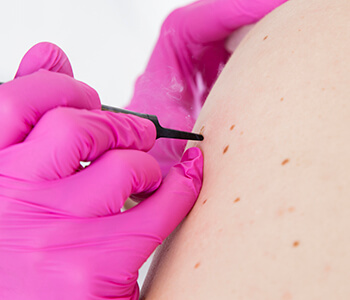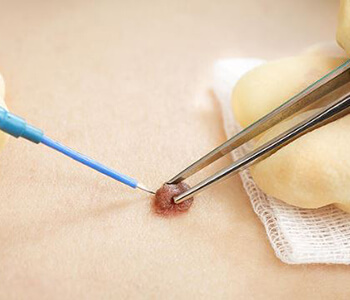Enjoy the “pros” and avoid the “cons” of mole removal with skilled surgery techniques in Algonquin
Posted by Dr. Vikram Khanna
Moles: To remove or not to remove?
Melanocytes are the pigment cells responsible for your dark skin or light eyes. Cells that cluster together are recognized as freckles, age spots or moles. Not all of moles conform to the “classic” look; they can be flat or raised, wrinkled or smooth. They can be hairy, and run the spectrum of colors, from brown to black, to pink, blue, tan, or red. In most cases, moles are harmless. But, before moving forward with any treatment, Dr. Khanna and his team will closely examine areas of concern to identify if the “mole” is just that, a benign spot, or something more insidious like precancerous actinic keratosis or melanoma.If you know the “ABCDE’s” of melanoma, you also know what to look for when it comes to “atypical” moles that may suggest a cancerous growth:
- A - Asymmetry, one half of the mole looks different than the other side
- B - Borders, are uneven or scalloped
- C - Colors, many may be present in a single mole such as brown and black instead of just uniformly brown or black
- D - Diameter, moles that stand out due to their size and are generally bigger than a pencil eraser
- E - Evolve, any changes to the mole may warrant a call to your trusted dermatologist team. Look for itching, bleeding, swelling, or crusting.
Many adults have anywhere from 10 to 40 common moles. But a lot of moles (100 or more) or one or more atypical moles are associated with greater risk of developing skin cancer. The risk increases with the number of dysplastic nevi; in fact, patients with at least 10 or more atypical moles reportedly have 12 times the risk of developing melanoma than the general population.
These types of statistics further underscore the need to closely monitor your moles with both self-checks and professional skin examinations. Dr. Khanna confirms if the mole is benign or otherwise, and any suspicious spots are biopsied by our skilled dermatopathologist partners. Even melanoma, the deadliest form of skin cancer, is easily treatable if diagnosed and removed early. There is no guessing if a cancer was removed precisely, because Dermatology Specialists of Illinois also use the most advanced surgical techniques such as Mohs Micrographic Surgery, which is the “gold standard” in treatment for many complex, recurrent, or large growths and those in cosmetically-important areas like the face.
If it’s a concern to you, it’s a concern to us
 A mole doesn’t have to be harmful for you to want it gone! You may feel it detracts from your appearance. A mole may also be uncomfortable when it rubs up against clothes or causes irritation when you shave. There are many “pros” or advantages to Dr. Khanna’s surgical excision or surgical shave approach to mole removal:
A mole doesn’t have to be harmful for you to want it gone! You may feel it detracts from your appearance. A mole may also be uncomfortable when it rubs up against clothes or causes irritation when you shave. There are many “pros” or advantages to Dr. Khanna’s surgical excision or surgical shave approach to mole removal:
- Regain your self-confidence!
- Eliminate the time and expense of covering up your mole with concealer and other products.
- Avoid complications, such as irritation or cuts to the mole.
- Mole removal is easy and affordable when done on an outpatient basis at our office.
- It’s fast – can be completed in an hour.
- Well-tolerated – little more than a numbing cream is needed for your comfort.
Dermatology Specialists of Illinois won’t know sure what is best until they see you. Call 844-307-7546 to schedule your consultation.





















